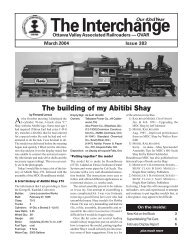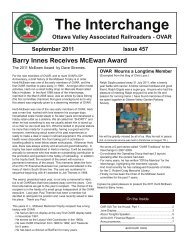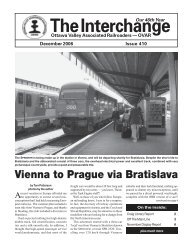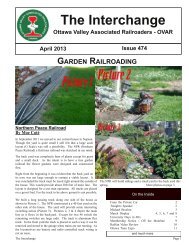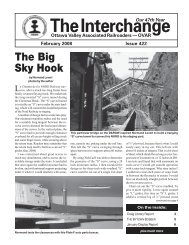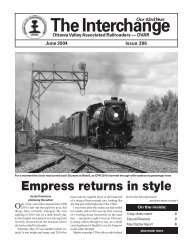March - Ottawa Valley Associated Railroaders
March - Ottawa Valley Associated Railroaders
March - Ottawa Valley Associated Railroaders
Create successful ePaper yourself
Turn your PDF publications into a flip-book with our unique Google optimized e-Paper software.
The Interchange<br />
<strong>Ottawa</strong> <strong>Valley</strong> <strong>Associated</strong> <strong>Railroaders</strong> OVAR<br />
<strong>March</strong> 2013 Issue 473<br />
NIPAWIN SK BRIDGE CONSTRUCTION<br />
Nipawin Saskatchewan double deck bridge construction<br />
Dominion Bridge photo / Mark A. Perry collection<br />
These fascinating photos are scanned DOMINION BRIDGE 4x5 negs from the collection of Mark Perry. These are B&W photos of<br />
the CPR bridge being built over the Saskatchewan River in Nipawin Saskatchewan 1929. Still standing, the railway crosses on the<br />
top and the automobiles drive on the single lane direction controlled road on the second level, UNDER the railway. CPR sold the line<br />
running between Nipawin and Choiceland to the newly formed shortline, the Torch River Railway.<br />
The most severe stresses on a bridge often take place during its<br />
construction.<br />
On the Inside<br />
This is a good example of the large stresses that can occur during bridge<br />
erection. Once built, the spans of this bridge will bow down between<br />
From the Private Car 2<br />
pillars, placing the top long girders in compression and the bottom ones<br />
Tonight's Speaker 2<br />
in tension. But quite the opposite is now taking place. The middle<br />
Herb l McEwen Award 3<br />
trusses are built in cantilever fashion, without any support. With the<br />
February Display 4, 5, 6, 8<br />
addition of King Posts and tension bars, the weight of the span and the<br />
Nipawin Bridge Construction 1, 7, 9<br />
crane booming out new beams is transferred back to the first truss.<br />
Great Western Railway Token 9<br />
Both trusses are experiencing stresses to make them bow up. Note the<br />
Railfan Video Review 10<br />
falsework required to build the first truss span, and how each tower is<br />
Changing Prototypes 11<br />
placed to support one bay of the truss. The middle truss needs two<br />
more bays before it reaches the pillar on the left.<br />
and much more<br />
continued on page 7<br />
The Interchange Page 1
FROM THE PRIVATE CAR<br />
I have been organizing in my train<br />
room for several weeks now, in the<br />
hope that I will have a big spurge<br />
of construction before spring.<br />
Much planning has been completed<br />
and most all of the supplies are at<br />
hand. I say most, because it always<br />
seems that there is just one thing<br />
missing when you get up to your elbows deep in the layout. My<br />
tools are now better located and easier to find with key tasks like<br />
soldering having their own tool caddy.<br />
that I don’t make any curves to tight. I also have a couple of<br />
calipers that are useful for taking dimensions off plans and aerial<br />
photos.<br />
Of course I have a good collection of jeweler’s screwdrivers<br />
and files as well as the obligatory set of xacto knives. There are<br />
lots of other great tools and if you have any special tools we<br />
should know about please let me know.<br />
Railroading is not how I make my living; it is how I live.<br />
Robert Peck<br />
There are some special tools that I find particularly handy. For<br />
trackwork, a pair of rail nippers is really indispensable. They<br />
make quick easy work of cutting rail. I remember back in the late<br />
seventies when we were setting up the first HOTRAK layouts<br />
using Dremel tools or heaven forbid an Atlas railsaw to cut rail.<br />
Rail nippers are just for cutting rail. Don’t use them to cut wire,<br />
especially piano wire as it is harder than the blades and will leave<br />
deep groves in your nippers. The manufacturer calls this abuse.<br />
For track nails I use a small hammer, but even though the head<br />
will fit between the rails, I always use a nailset. This ensures that<br />
I don’t dent the rail and I can control the depth of the nail to<br />
ensure that the ties don’t get deformed and change the track<br />
gauge. I drill hole for nails in the ties using a pin vise. The one I<br />
have has a big swivel knob on one end that spins easily in my<br />
palm. I have several NMRA standards gages as well as three<br />
point track gages. Probably one of the best tools I found for<br />
putting on railjoiners is an ME Stainless Steel Rail Joiner<br />
Installation Tool. These were made by Marv Selzer, but are no<br />
longer available.<br />
I have used many tools for soldering but I found that the set sold<br />
by FastTracks works best. They sell a good iron with nice fine<br />
solder, perfect for trackwork. I use different irons for under<br />
layout electrics. I even bought a jewelers saw for cutting rail<br />
gaps in preassembled turnouts.<br />
I use KD couplers and love their tools. There are four that I<br />
cannot live without. First is a KD coupler height gage. I have<br />
three, two are on the work bench on either end of the test track<br />
and one is available to travel to any location on the railroad.<br />
Second, is a pair of coupler trippin pliers. These are the just right<br />
tool for the job and have stopped me from breaking couplers<br />
using the wrong tool. They were worth the price in unbroken<br />
couplers. Third is a KD Springpick. This small tool has also<br />
paid for itself in preventing those little KD knuckle springs from<br />
flying all over the train room. Again it is simply the right tool for<br />
the job. Fourth, I use graphite as a coupler lubricant and it really<br />
helps prevent sticky couplers. Of course I have a good supply of<br />
washers and coupler mounting screws for those awkward cars<br />
and that means I also have the necessary taps and drills.<br />
For measuring I really like scale rules and have several,<br />
including some that are transparent. For laying out curves I use<br />
two types of trammels, either string or ruler. I also have a couple<br />
of curve templates for curves that I can’t get to the centre of. I<br />
keep a piece of Atlas 22 inch radius curve track handy to ensure<br />
Page 2<br />
Tonight's Speaker is Bill Scobie<br />
Bill has been a model railroader for about 50 years. It all started<br />
back in his late teens when he wrecked three flying models in one<br />
day. So that's when he started to look a little harder at model<br />
railroading.<br />
Bill had an old American Flyer set that went twice around a 4X8<br />
sheet of plywood. He could do 200 mph with this train, but it was<br />
not what he was looking for. So Bill took it all down to<br />
Hobbyland and traded it for his first HO set. You guessed it, the<br />
Athearn Hustler. This thing did 500 MPH but it was a start. From<br />
there Bill started to look at a free lance layout as there were not<br />
too many around at that time. So off he went picking up what he<br />
liked.<br />
Along comes the October 1969 Trains Magazine, the all narrow<br />
gauge issue. The story by William Moedinger of his 1939 trip to<br />
the Rio Grande Southern Railroad. The one photo of engine 20<br />
leading engine 455 with the brakeman riding the pilot of number<br />
20 so the crew could see a little farther down the track and avoid<br />
possible trouble. Bill was hooked and out and out went some<br />
trains and in came HOn3 D&RGW RGS trains. The down side is<br />
that he also got interested in the broad gauge trains. Got a little<br />
off track.<br />
It wasn't till he built his house in 1981 did it become clear that<br />
HO/HOn3 was not going to work. In his own words: in 1984 my<br />
first Sn3 came in the door and by 1986 the HO/HOn3 was out<br />
the door and the Sn3 was coming in. And today I have not too<br />
bad a layout that runs and we can have fun with.<br />
I send a lot of time in narrow gauge country having been there<br />
some twenty times. My most nitrous trip was in 2010 when Russ<br />
Sperry cleaned the boiler of engine 489 on top of the 10015 foot<br />
Cumbres Pass. We had paid to have it painted green but it didn't<br />
look green. It did when we were finished.<br />
I am also into Canadian aviation and too many other things.<br />
Bill Sn3<br />
The Interchange
Herb L. McEwen Award<br />
CALL FOR NOMINATIONS<br />
By Barry Innes<br />
Well it's that time of year again. At the April OVAR meeting,<br />
next month, you will find nomination forms on your table for<br />
nominations for the H. L. McEwen award.<br />
This will be the 46th time that this trophy has been awarded.<br />
This award is not only to remember Herb McEwen, but also to<br />
honour OVARian’s who have passed on over OVAR's 52 years. If<br />
you would like to nominate someone who you feel has made an<br />
outstanding contribution to OVAR or model railroading, fill out<br />
the nomination form and pass it on to me at the April or May,<br />
2013 meetings of OVAR.<br />
Please DO NOT sign the nomination form as forms that are<br />
signed will NOT be accepted. Remember, no nominations can be<br />
accepted after the May, 2013 meeting and the committee<br />
operates independently of the OVAR executive.<br />
2005 38 Roger Eaton<br />
2006 39 John LeBlanc<br />
2007 40 Jacques Thuot<br />
2008 41 Grant Knowles<br />
2009 42 Bob Peck<br />
2010 43 Graham Stremes<br />
2011 44 Barry Innes<br />
2012 45 Chris Lyon<br />
2013 46 ______________<br />
UNWEATHERING EFFORTS<br />
Bill Scobie and Russ Sperry to the rescue<br />
Our heroes had paid good money to have the engine painted<br />
green, only to find her under so much weathering that she did not<br />
look green at all. So here they are undoing what they so painfully<br />
try to do in their model world. Train modellers are strange<br />
people!<br />
Below, for your information, is a list of former winners of this<br />
award.<br />
YEAR Car # NAME<br />
1968 1 Joe Thomas (D)<br />
1969 2 Bob Craig (D)<br />
1970 3 Adrian French (D)<br />
1971 4 Gunther M. "Toots" Eggert (D)<br />
1972 5 Bill Williams Sr (D)<br />
1973 6 Doug MacKenzie (D)<br />
1974 7 Tom Hood<br />
1975 8 Dave Knowles<br />
1976 9 Brian "Boomer" Ludlow (D)<br />
1977 10 Jim Jarrett (D)<br />
1978 11 Reg Bilodeau (D)<br />
1979 12 Al Craig<br />
1980 13 Tony Chinery (D)<br />
1981 14 Odfried Wendler (D)<br />
1982 15 Bill Scobie<br />
1983 16 Tony Mitchelson<br />
1984 17 Jim Simpson (D)<br />
1985 18 Ross Peever (D)<br />
1986 19 Omer Lavallee (D)<br />
1987 20 Bill Irwin<br />
1988 21 Michel Boucher<br />
1989 22 Bruce Curry<br />
1990 23 Dave Stremes<br />
1991 24 Brian Earl<br />
1992 25 Dave Venables<br />
1993 26 Ron Shurtliff<br />
1994 27 Carl Swail<br />
1995 28 Ken Healy (D)<br />
1996 29 Jim Nelson (D)<br />
1997 30 Stu Waldron (D)<br />
1998 31 David Steer<br />
1999 32 Marty Phillips<br />
2000 33 Steve Adamson<br />
2001 34 Angus Palmer<br />
2002 35 Mike Hamer<br />
2003 36 Peter Nesbitt<br />
2004 37 Earl Roberts<br />
DRG&W 489, Chama, New Mexico, Sep 2009 Chris Zygmunt<br />
The Interchange Page 3
February Display Passenger Equipment.<br />
Photos by Mike Hamer.<br />
Your absent minded editor forgot to gather all the display<br />
cards, my apologies to those whose names went missing.<br />
G scale. Early internal combustion self propelled train, obviously maintained in pristine condition.<br />
Carl Swail, HO, three turn of the previous century wood<br />
cars. The combine is a Rutland car.<br />
The passenger equipment theme brought beautiful trains.<br />
All were interesting as models as well. On top, Chris Lyon<br />
brought 1959 Fleischman HO gauge tinplate of a Santa Fe<br />
highlevel coaches and observation and below of a New<br />
Haven ligthweight train pulled by a very German<br />
Pennsylvania steam locomotive. In the middle, Brian Earl<br />
displayed an N scale Hiawata, with a streamlined Atlantic<br />
pulling a seven car train. The whole train is a fine example<br />
of Art Deco industrial design. On the lower shelf, Bob<br />
Meldrum brought his dream train. Three heavyweights<br />
pulled by a massive CN 484. As befits premium trains,<br />
not a speck of dust or road grime could be found anywhere.<br />
Brian Earl's Milwaukee Road Hiawata streamlined Atlantic.<br />
Page 4<br />
Bob Meldrum's dream train, HO<br />
Mogul with smoke lifters<br />
The Interchange
February Display structures and more<br />
Continued from page 4.<br />
Kelley’s Boarding House Mike Hamer<br />
Rusty Stumps Scale Model<br />
Introduction:<br />
This model is one of five in Rusty Stumps Scale Models’<br />
“Kelley’s Landing Series”. I had already built one of the other<br />
structures from the series and enjoyed the modelling experience.<br />
I ordered this second kit as I liked the look of the structure with<br />
its false front, upper landing and double staircase along the side<br />
wall. A boarding house could fit any local in the country, so this<br />
was a “must have” for my future layout expansion. I chose to<br />
build the structure “as is” right down to the same colours as<br />
found in the image on the front of the manual!<br />
Painting:<br />
The walls are painted with acrylic “Parchment” with the trim<br />
given an acrylic “Teddy Bear Tan” coat of paint. Weathering is<br />
an alcohol and India Ink wash as well as some dry brushing of<br />
powders.<br />
Signs:<br />
Many of the signs provided in the kit were decals. Others I found<br />
on the Internet and printed , then resized to fit my dimensions.<br />
Side Brick Addition:<br />
Construction:<br />
The small brick structure jutting out on the left side of the<br />
All wall sections are of twopiece construction, a subwall and an<br />
building adds some additional relief to the long, flat wall. It is<br />
exterior wall that you laminate together. Interior room walls,<br />
one of the many resin offerings from a company called<br />
floors and exterior walls are fit together using tab construction<br />
RailroadKits. I simply washed the resin piece before painting<br />
with all the openings for the tabs aligning beautifully. Templates<br />
and weathering.<br />
offer the modeller ease in construction of all exterior detailing<br />
such as landings, railings and staircases. Special roof supports Conclusion:<br />
act as trusses and are placed at regular intervals ensuring a good This was a fun kit to build with its interesting rooflines and<br />
roof fit. Additional bracing is unnecessary as the combined exterior details. It will fit nicely on a diorama for the time being.<br />
efforts of the floor and interior wall sections offer considerable It will eventually reside on my future expansion to my layout.<br />
strength throughout the structure.<br />
LEFT Modeller unknown HO scale,<br />
beautifully painted and weathered gaselectric<br />
self propelled combine in Boston and<br />
Maine colours.<br />
RIGHT John Moore HO scale<br />
Canadian Pacific 'R' class car.<br />
The rest of the information was<br />
hidden. The window<br />
arrangement suggests a diner<br />
to me, but a kitchen car would<br />
require a small door for<br />
provisions.<br />
More Display photos on page 6<br />
The Interchange Page 5
February Display<br />
Continued from page 5.<br />
Unknown, HO scale, an exquisite model of a B&O wagon<br />
top caboose (crummy?) in factory fresh mint condition.<br />
Colin Churcher, brass replica of GWR Coat of Arms casting<br />
applied to 1894 single driver locomotives.<br />
Grant Miles, OO scale, Great Weatern Railway 042T with cream and brown rolling stock. Also displayed, a rake of<br />
cream and dark red cars with diaphrams. Possibly suburban commuters and long distance trains carriages?<br />
Unknown displayer,<br />
HO scale, a string of four reefers; two cars were Athearns<br />
repainted in Central Vermont and Hood's colour, the<br />
Supplee is believed to be an MDC car. The New York,<br />
Ontario & Western car is possibly scratchbuilt. The ageing<br />
paint effects are very impressive.<br />
Chris Lyon, HO scale. Two 1959 Fleischman sets made for<br />
US Military posted in Germany market. A Santa Fe Alco<br />
FA2 with high level coaches, and a New Haven set pulled<br />
by a PRR Mogul. Interesting pieces of HO modelling<br />
history, as these trains were nearly 54 years old.<br />
Page 6<br />
More Display<br />
photos on<br />
page 8<br />
The Interchange
Note lack if tie plates under rails and spike every fourth tie<br />
during construction.<br />
Right, building the second truss.<br />
One can see the lower deck for road traffic attached to the side<br />
of the steel tower. The next span will bring the road to the lower<br />
deck of the trusses.<br />
Below, main river crossing completed<br />
By December, Dominion Bridge has completed the four truss<br />
spans over the river and reached the west bank. It is now a<br />
"simple" matter of installing the support towers and the girders<br />
for the deck girder rail bridge. Note that most of the falsework<br />
under the first truss span has been removed. The crane near us<br />
is the same as other photos, but the cab is nearly the same colour<br />
as the background, making it hard to discern against it.<br />
You will find more photos on page 8.<br />
Left, King Posts Above, Building the first truss.<br />
The thin members on the left will be in tension when the bridge is completed,<br />
but they will have to support the weight of the crane during construction.<br />
The Interchange Page 7
February Display<br />
Continued from page 6.<br />
A beautiful display case with VIA rolling stock. The set and display was made for a VIA official.<br />
Bill Crago, no scale. Bill brought samples of 3 volts<br />
LED that do not require soldering a resistance or<br />
longer leads. They come with six inches lead and<br />
can be connected to a variety of 3 volts batteries.<br />
They are available in many colours, and with<br />
special effects. Bill recommended to go to<br />
www.modeltrainsoftware.com for more details.<br />
Above two photos<br />
John Chambers HO Intermountain PS1 50ft modified with with<br />
cushion under frame. Car was featured in the Oct 08 Interchange,<br />
and a Kadee model of same car.<br />
Photos on the left Robert Peck, HO scale.<br />
Rob brought rolling stock from John Licharson's St Boniface, Lac<br />
des Bois and Kaministiquia Railway now on permanent loan to<br />
Rob. There was a string of three 34 ft hoppers custom decorated<br />
by John, and in Intermountain stock yard modified with new roof<br />
and custom lettering.<br />
Gilbert Lacroix, G scale<br />
At the urging of Fred Mills, Gilbert cast<br />
a prototype 6/6 Freight Shed window.<br />
Gilbert is interested in comments from G<br />
scale modellers.<br />
Bottom photos<br />
Overview of the Display. There is room<br />
for your models!<br />
Everything is<br />
welcome at the<br />
Display. Bring<br />
work in progress,<br />
bring old, bring<br />
new, bring<br />
whatever you like.<br />
And I will put on<br />
my task minder to<br />
pick up faithfully<br />
your Display<br />
Cards! Normand<br />
Page 8<br />
The Interchange
Changing Prototypes<br />
(But Keeping All My Stuff) By David Moat<br />
When Santa Claus left a ‘Marx’ tinplate New York Central<br />
electric train set under the tree for my fourth Christmas, he<br />
probably had no idea that that simple gift would make me a lifelong<br />
model railroader and a stalwart fan of the NYC. Oh, I did<br />
have my diversions. When I moved into HO scale in 1969, I<br />
thought it ‘unpatriotic’ to model a “foreign” railroad, so I decided<br />
to model the CNR. But even then, my very first HO purchase was<br />
an Athearn boxcar kit resplendent in the NYC ‘Pacemaker’<br />
scheme.<br />
So in keeping with the fervor of Canadian patriotism, my<br />
original <strong>Ottawa</strong> <strong>Valley</strong> & Northern and its successor Ontario<br />
Eastern were actually freelanced lines that featured CNR motive<br />
power and rolling stock, while the later Ontario & Quebec saw a<br />
move into CPR equipment, but hosted CNR trains via trackage<br />
rights. But the NYC always had a special place in my heart.<br />
When the demise of my first marriage resulted in a tenyear<br />
hiatus from model railroading, all of my “stuff” was carefully<br />
wrapped, boxed, and stored, awaiting my inevitable return to<br />
active model railroading. When I did return, my thinking had<br />
matured to the point that I was going to model what I REALLY<br />
liked, and what I really liked was the New York Central circa<br />
1956 to 1958. I had been modeling the mid1970’s, so I sold off<br />
most of my rolling stock and motive power, and began to<br />
accumulate NYC equipment (suitably seasoned with the<br />
occasional soupcon of CPR equipment).<br />
All should have been right with my HO world. As I sat down at<br />
my work table a few months ago, I was all set for an enjoyable<br />
evening of modeling. Handel’s ‘Water Music’ was playing on the<br />
stereo, and a glass of Cabernet Sauvignon sat breathing on the<br />
corner of the work table. My tools were laid out, and a rather<br />
battered old Front Range TH&B boxcar sat waiting my<br />
ministrations to restore it to serviceable condition. But something<br />
was nagging at the back of my brain.<br />
I had begun work on my ‘Ontario & New York Railway’ – a<br />
westwardtoToronto extension of NYC’s Cornwall to <strong>Ottawa</strong><br />
line. However, no matter how hard I rationalized, the concept of<br />
a doubletracked and heavily trafficked New York Central<br />
subsidiary through rural Lanark County was totally illogical. The<br />
routing of heavy freight and toplink passenger trains between<br />
Utica and Toronto via <strong>Ottawa</strong> made the concept even more<br />
ludicrous. The O&NY was abandoned and dismantled earlier this<br />
year before it ever turned a wheel. That was what was nagging at<br />
me as I worked away on repairing that TH&B Boxcar.<br />
And then – an epiphany! The answer to my problem was right<br />
there in front of me, in the form of that TH&B boxcar. Why not<br />
model the Toronto, Hamilton & Buffalo? The TH&B not only ran<br />
its own trains behind its own motive power, but being jointly<br />
owned by NYC and CPR, it also featured trains from those<br />
august prototypes.<br />
The muse of inspiration rode in on TH&B 3735, Handel’s<br />
Water Music, and a glass of Cabernet Sauvignon . . . .<br />
passenger station, and Hunter St. station fills that bill nicely.<br />
What other railway changed engines three times (CPR to TH&B<br />
to NYC) in one hundred miles? And as a clincher, the TH&B belt<br />
line around the east side of Hamilton would provide plenty of<br />
heavy industry to originate and receive freight shipments and<br />
require switching activity galore. I was one with Paul on the<br />
road to Damascus!<br />
As a bonus, I can keep and run all my favourite NYC and CPR<br />
rolling stock and motive power. Some of it might be a bit of a<br />
stretch – my prized ABA trio of NYC FairbanksMorse “Erie<br />
Builts” for example. But if the prototype NYC ran “ErieBuilts”<br />
in passenger service through nearby Waterford, Ontario on the<br />
Canada Southern as shown on page 107 of New York Central<br />
System Diesel Locomotives (Edson, TLC Publishing, 1995), then<br />
my freight service “ErieBuilts” are but not beyond the realm of<br />
possibility.<br />
The die has been cast. I am indeed changing prototypes and<br />
keeping all my NYC and CPR stuff. However, I will need more<br />
motive power and rolling stock – all in TH&B livery. But for a<br />
guy who loves building and painting railway equipment, how<br />
much of a chore can that be?<br />
It had everything I wanted; heavy CPRTH&BNYC freight<br />
traffic and toplink passenger trains with NYC sleeping cars<br />
St Thomas, fall 1997<br />
connecting Toronto to New York, Boston, Cleveland, and<br />
Ontario Central Railway repainting second hand CPR locos in<br />
Pittsburg (and vice versa). Even the CPR ran sleeping cars over it the TH&B colours. An RS18 and an RS23 still needing grille,<br />
that originated in Montreal and <strong>Ottawa</strong> and terminated at headlights and number boards. There was a C424 in these<br />
TH&B’s Hunter St. station in Hamilton. I wanted a major colours as well. Normand Levert<br />
The Interchange Page 11
OVAR<br />
Coming in April<br />
After Dinner Presentation<br />
John Mitchell<br />
New York Central<br />
Michigan Central<br />
in Ontario<br />
Directory<br />
20122013<br />
Chair: Robert Peck 6132694193<br />
Vice Chair: Peter Jackson 8197782737<br />
Secretary: Mike Shore 6138298867<br />
Treasurer: David Copeland 6138255027<br />
Membership: John Howard 6137223155<br />
Program: Andy Chisholm 613 2580089<br />
Dinner: Fred Mills 6137231911<br />
Archives: Dave Knowles 6137224473<br />
Webmaster: Steve Watson 6135923609<br />
Video Library: Bill Scobie 819 6846212<br />
Interchange: Normand Levert 6138677904<br />
Web Site: www.ovar.ca<br />
The Display<br />
STRUCTURES<br />
Next OVAR Meeting:<br />
Tuesday, April 9, 2013.<br />
St.Anthony Soccer Club Hall<br />
523 St. Anthony Street,<br />
<strong>Ottawa</strong><br />
(just off Preston Street at the Queensway)<br />
Doors open at 5:30 p.m.<br />
Dinner served at 6:30 p.m.<br />
Admission: $25.00<br />
Includes dinner, facilities, program, expense, taxes and<br />
gratuities. Free parking available at St. Anthony SC or<br />
the Adult High School.<br />
Please note.<br />
If you cannot attend the dinner after saying you would,<br />
please call Fred Mills, the Dinner Chair, at 6137231911.<br />
Thank you.<br />
February Dinner Attendance 114<br />
The Interchange<br />
<strong>March</strong> 2013 – Issue 473<br />
Staff<br />
Features, story ideas, comments.<br />
Email to the Editor: ovar.interchange@gmail.com<br />
Distribution and mailing.<br />
Mike Shore<br />
25 Bainbridge Ave<br />
<strong>Ottawa</strong> ON K2G 3T1<br />
6138298867<br />
Submission of articles.<br />
The Interchange welcomes your submissions that<br />
may be of interest to club members. Material can<br />
be submitted to the Editor via email, memory stick,<br />
CD, DVD, typewritten, or even handwritten.<br />
Copy Deadline.<br />
April Issue, <strong>March</strong> 21st.<br />
Printing and copying.<br />
Impression Printing, Smiths Falls.<br />
The Interchange is published ten times a year,<br />
September through June, by the <strong>Ottawa</strong> <strong>Valley</strong><br />
<strong>Associated</strong> <strong>Railroaders</strong>. Opinions expressed are<br />
those of the Editors or individual authors, and are<br />
not necessarily those of OVAR.<br />
©2013.<br />
Page 12<br />
The Interchange



